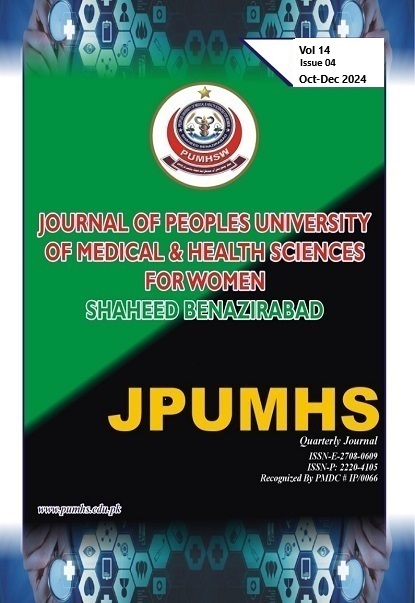ENDOMETRIAL HYPERPLASIA IN OBESE PATIENTS OF REPRODUCTIVE AGE PRESENTED WITH ABNORMAL UTERINE BLEEDING.
JPUMHS;2024:14:04,87-93. http://doi.org/10.46536/jpumhs/2024/14.04.564
Keywords:
Abnormal uterine bleeding, Endometrial hyperplasia, Obese patients, Reproductive age.Abstract
BACKGROUNG: Abnormal uterine bleeding AUB is commonly reported at the
gynecological OPDs as approximately 1 in every 3 patients in these OPDs reports about this
complaint OBJECTIVES: This Study aimed to determine the frequency of endometrial hyperplasia
in obese patients of reproductive age with abnormal uterine bleeding. METHODS: This cross
sectional study was carried from 1st of March 2023 to 31st July 2023 at the Department of
Gynaecology and Obstetrics District Head Quarter Hospital, Mardan. A total of 213 women between
the ages of 18-40 years with BMI≥ 30 kg/m2 with complaint of abnormal uterine bleeding were
included in this study. Endometrial thickness was assessed through transvaginal ultrasonography.
Endometrial hyperplasia was diagnosed when ultrasonography showed quite 7 mm thickness of
endometrium within two days after the end of menstruation. Statistical analysis was done using IBM
SPSS Version 25. RESULTS: The Mean age was 29.36±6.52 years, range from of 18-40 years. The
mean BMI was 32.83±2.27 while mean parity was 1.73±1.26. Results of transvaginal ultrasonography
show the presence of endometrial hyperplasia in 13.15% of these obese women. BMI stratification
ratio showed higher in patients endometrial hyperplasia BMI≥35 than patients with BMI˂35 although
the difference was not statistically significant. CONCLUSION: The obese women consulting for
abnormal uterine bleeding in their reproductive age have a considerable risk for the development of
endometrial hyperplasia and must be assessed for its diagnosis.
Downloads
Downloads
Published
How to Cite
Issue
Section
License

This work is licensed under a Creative Commons Attribution-NoDerivatives 4.0 International License.




